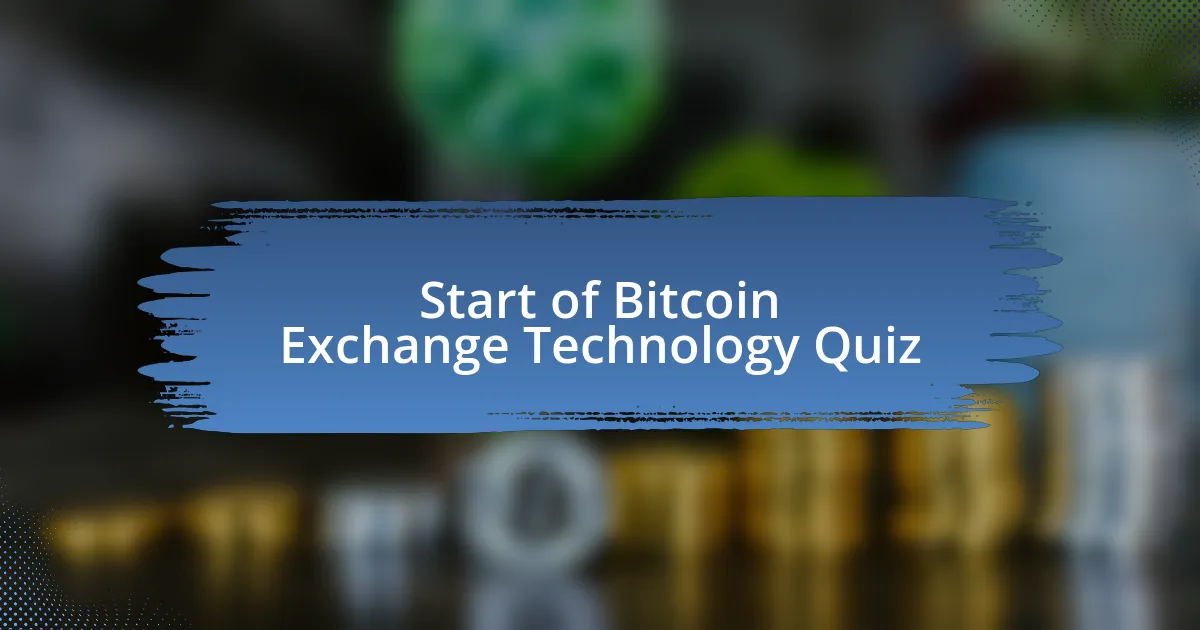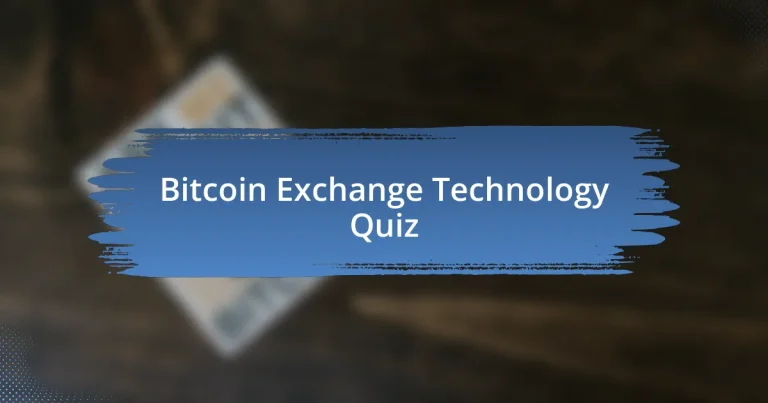
Start of Bitcoin Exchange Technology Quiz
1. What is a cryptocurrency exchange?
- A place where people can buy physical gold and silver coins.
- An app for booking flights at discounted prices.
- A platform where participants can trade cryptocurrencies, similar to traditional stock and commodities exchanges.
- A site for swapping collectible trading cards among users.
2. What are the main types of cryptocurrency exchanges?
- Auction, gas, and fiat exchanges
- Peer-to-peer, multi-currency, and wallet exchanges
- Binary, analytic, and social exchanges
- Centralized, decentralized, and hybrid exchanges
3. What is a centralized cryptocurrency exchange (CEX)?
- A network where users can trade directly without any fees.
- An app that provides trading signals and market analysis for cryptocurrencies.
- A platform that acts as an intermediary between buyers and sellers, making money through commissions and transaction fees.
- A place where cryptocurrencies are mined using powerful computers.
4. What is a decentralized cryptocurrency exchange (DEX)?
- A service that offers loans to individuals using cryptocurrency as collateral.
- A stock trading platform for buying and selling shares in public companies.
- A platform that allows peer-to-peer transactions directly from digital wallets without an intermediary, relying on smart contracts.
- A marketplace for exchanging physical goods like art and antiques.
5. How do centralized exchanges operate?
- Through a random selection of buyers and sellers with no consideration of pricing or order management.
- By allowing direct peer-to-peer trades without any intermediary or structured system at all.
- By relying solely on user-driven pricing without any systematic structure or execution process.
- Using an order book system where buy and sell orders are listed and sorted by price, and the matching engine matches buyers and sellers based on the best executable price.
6. What is an order book in cryptocurrency exchanges?
- A summary of all the users registered on an exchange.
- A collection of advertisements for various cryptocurrencies available for trade.
- A report of recent transactions that determines market prices.
- A live list of buy and sell orders that directly impact the exchange rate of the respective cryptocurrency.
7. What is a maker and taker fee in cryptocurrency exchanges?
- Fees charged by exchanges for creating (maker) or taking (taker) orders, varying between 0.015% to 0.75%.
- Penalties for users who withdraw cryptocurrencies from their accounts frequently.
- Tax deductions applied to trading profits made on cryptocurrency exchanges.
- Charges for trading only on decentralized exchanges, with no percentage fees involved.
8. What is the role of a matching engine in a cryptocurrency exchange?
- To provide customer support for trading inquiries and issues.
- To convert cryptocurrencies into cash automatically at market rates.
- To match buyers and sellers based on the best executable price given the desired lot size.
- To execute trades on behalf of users without their input or permission.
9. How do decentralized exchanges prevent market manipulation?
- By allowing peer-to-peer transactions and using smart contracts, which reduce transaction costs and prevent fake trading and wash trading.
- By monitoring trading activity 24/7 and utilizing algorithms to identify suspicious behavior.
- By using a centralized order book that matches buyers and sellers to create market prices.
- By implementing strict KYC procedures and identity verification for all users to track transactions.
10. What is KYC in cryptocurrency exchanges?
- Keep Your Coins, a method for storing digital assets safely.
- Know Your Customer, a process of verifying users` identities to comply with regulations.
- Key Your Currency, a technique for generating wallets.
- Knowledge of Your Clients, a strategy for market research.
11. What is the difference between fiat and digital currencies?
- Fiat currencies are only available in physical form, while digital currencies are only virtual.
- Fiat currencies are safer than digital currencies, which can be hacked easily.
- Fiat currencies are issued by governments, while digital currencies are decentralized and secured by cryptography.
- Fiat currencies have no value, while digital currencies have intrinsic worth.
12. What is a blockchain?
- A social media platform for trading
- A type of cryptocurrency wallet
- A digital ledger where data is stored on a network of independent computers
- A software application for video games
13. What is a node in a blockchain network?
- A security feature that encrypts blockchain data
- A type of digital currency used for transactions
- A standalone software application for trading assets
- A computer or device connected to other computers that all hold a copy of a blockchain
14. What is a public key in cryptocurrency?
- A fee for transactions
- A private key for trading
- A password for a user account
- A crypto wallet address
15. What is the purpose of a hybrid cryptocurrency exchange?
- To serve as a legal entity for issuing new cryptocurrencies through ICOs.
- To create a completely anonymous trading platform without any regulations or controls.
- To exclusively provide trading options for only fiat currencies.
- To combine the strengths of both centralized and decentralized exchanges by facilitating centralized matching of orders and decentralized storage of tokens.
16. What is Binance, and what is its significance in the cryptocurrency market?
- Binance is a type of digital wallet for storing Bitcoin.
- Binance is a mobile app for tracking cryptocurrency prices.
- Binance is a popular cryptocurrency exchange that dominates the exchange space with over $72.63 billion USD of daily crypto trading volume.
- Binance is a social media platform for cryptocurrency discussions.
17. What is Binance U.S., and what does it offer?
- Binance U.S. is an investment bank focused on fiat currency transactions.
- Binance U.S. is a physical store providing cryptocurrency hardware.
- Binance U.S. is a branch of Binance that allows U.S. citizens to trade certain approved cryptocurrencies.
- Binance U.S. is a social media platform for cryptocurrency discussions.
18. What is the BNB token, and how is it used on Binance?
- The BNB token is primarily used for buying stocks on the Binance stock exchange.
- The BNB token serves as a stablecoin for trading fiat currencies on Binance.
- The BNB token is used for transactions on the Binance platform, which can significantly lower the cost of trading.
- The BNB token is a governance token for decision-making in the Binance community.
19. What are the fees charged by Binance?
- Binance does not charge any fees for trading at all.
- Binance charges a maker and taker fee between 0.015% to 0.75% and a trading fee of 0.1%.
- Binance charges a monthly subscription fee of $50.
- Binance has a flat fee structure of $5 per transaction.
20. What is Bittrex, and what are its key features?
- Bittrex is a social media platform focusing on cryptocurrency discussions.
- Bittrex is a small to mid-sized exchange based in Washington State, known for its security and wide support for cryptocurrency asset conversion.
- Bittrex is a decentralized platform for trading stocks and commodities.
- Bittrex is a mobile app that helps users mine cryptocurrencies easily.
21. What is the fee structure of Bittrex?
- Bittrex charges a maker and taker fee between 0.08% – 0.20%.
- Bittrex charges no fees for any transactions.
- Bittrex charges a flat fee of $5 per transaction.
- Bittrex charges a maker and taker fee between 0.01% – 0.05%.
22. What is OKEx, and what are its notable features?
- OKEx is a government regulatory body for cryptocurrency.
- OKEx is a hardware wallet for storing digital currencies.
- OKEx is a cryptocurrency exchange that supports major countries and operates a C2C trading system.
- OKEx is a social media platform for cryptocurrency discussions.
23. What is the fee structure of OKEx?
- OKEx charges a flat fee of 0.50% for all transactions[1].
- OKEx works on a maker and taker fee that fluctuates between 0.060% and 0.100%[1].
- OKEx uses a monthly subscription fee for trading services[1].
- OKEx has a tiered fee structure ranging from 0.010% to 0.020%[1].
24. What is Coinbase, and what are its key features?
- Coinbase is a decentralized platform that solely facilitates peer-to-peer cryptocurrency transactions.
- Coinbase is an unregulated exchange for trading stocks and commodities in the U.S. market.
- Coinbase is a social media platform for sharing cryptocurrency investment strategies and tips.
- Coinbase is a fully regulated and licensed crypto exchange that operates in over 100 countries, offering a user-friendly interface and insured custodial wallets.
25. How does Coinbase protect its users` investments?
- Coinbase relies solely on user-generated passwords for protection.
- Coinbase uses peer-to-peer exchanges for transaction security.
- Coinbase encrypts all user data but does not insure assets.
- Coinbase offers insured custodial wallets to protect traders` investments.
26. What is the primary function of a Bitcoin exchange?
- To act as an intermediary between buyers and sellers, facilitating the trading of Bitcoins using different fiat currencies or altcoins.
- To issue new cryptocurrencies and manage token sales.
- To offer investment advice and tips for trading strategies.
- To provide a secure wallet service for storing cryptocurrencies.
27. How do Bitcoin exchanges match buyers with sellers?
- Through a decentralized blockchain that automatically executes trades without a matching process.
- Using an order book system where buy and sell orders are listed and sorted by price.
- By randomly pairing buyers and sellers without considering the price of orders.
- By utilizing a peer-to-peer network that eliminates the need for price sorting.
28. What are market orders and limit orders in Bitcoin exchanges?
- Market orders allow buyers to dictate prices, while limit orders require sellers to adjust prices.
- Market orders set a predetermined price, while limit orders execute trades at the best available price.
- Market orders execute trades immediately at the best available price, while limit orders set a specific price for buying or selling.
- Market orders delay trades until market conditions are favorable, while limit orders execute trades right away.
29. What is the process of registering and verifying identity on a regulated Bitcoin exchange?
- Digital wallet setup
- KYC process
- ICO registration
- Exchange listing request
30. What is the role of smart contracts in decentralized exchanges?
- Smart contracts automate peer-to-peer transactions, reducing costs.
- Smart contracts act as custodians of user funds.
- Smart contracts offer insurance for user investments.
- Smart contracts serve as user interfaces for exchanges.

Quiz Completion: Well Done!
Congratulations on completing the quiz on Bitcoin Exchange Technology! You’ve taken a significant step towards understanding this complex yet fascinating topic. Through this quiz, you’ve likely learned about the mechanisms behind cryptocurrency exchanges, the importance of security, and how trading works in the digital currency landscape. Such knowledge is crucial as the world of Bitcoin continues to evolve and influence global finance.
Participating in this quiz not only tested your existing knowledge but also expanded your insights into the intricacies of Bitcoin exchange systems. You explored concepts like market orders, liquidity, and the role of exchanges in the cryptocurrency ecosystem. This understanding can help you make informed decisions whether you are trading, investing, or simply curious about Bitcoin.
We invite you to dive deeper into the topic by exploring the next section on this page. Here, you will find valuable resources and detailed information about Bitcoin Exchange Technology. Whether you want to enhance your trading skills or grasp the technical underpinnings of exchanges, this section is designed to broaden your understanding. Happy learning!

Bitcoin Exchange Technology
Overview of Bitcoin Exchange Technology
Bitcoin exchange technology refers to the systems and processes that facilitate the buying, selling, and trading of Bitcoin. These exchanges act as intermediaries, allowing users to exchange fiat currencies for Bitcoin and vice versa. The technology behind these exchanges includes secure wallets, trading engines, and user authentication protocols. The rise of decentralized exchanges also represents a significant evolution in this space, enabling peer-to-peer transactions without the need for a central authority.
Types of Bitcoin Exchanges
There are primarily two types of Bitcoin exchanges: centralized and decentralized exchanges. Centralized exchanges manage user accounts and transactions, providing liquidity and services through a central server. Users typically create accounts and trust the exchange with their funds. In contrast, decentralized exchanges (DEXs) operate without a central authority, allowing users to trade directly with one another using smart contracts on blockchain technology. This model enhances privacy and reduces the risk of central point failures.
Key Features of Bitcoin Exchange Platforms
Bitcoin exchange platforms offer several key features essential for trading. These include order types (market, limit, stop orders), liquidity provisions, and trading pairs. Security measures, such as two-factor authentication and cold storage of funds, are critical for user protection. User-friendly interfaces and real-time price charts enhance the trading experience. Additionally, some exchanges offer advanced tools like margin trading and futures contracts, catering to sophisticated traders.
Security Protocols in Bitcoin Exchanges
Security is paramount in Bitcoin exchange technology. Exchanges implement numerous protocols to safeguard assets. Common practices include end-to-end encryption, secure sockets layer (SSL) for data transmission, and regular security audits. Cold wallets, which are offline storage methods, are used to protect the majority of funds. Furthermore, many exchanges employ withdrawal whitelists, limiting where funds can be sent. These measures are crucial in minimizing the risk of hacks and thefts.
Future Trends in Bitcoin Exchange Technology
The future of Bitcoin exchange technology is poised for significant advancements. Innovations such as decentralized finance (DeFi) will further enhance DEX functionalities. There is a growing trend toward integrating artificial intelligence for fraud detection and automated customer service. Regulatory shifts may also influence operational models, pushing exchanges toward greater compliance. Lastly, the implementation of blockchain interoperability can simplify cross-chain transactions, making exchanges more versatile and user-friendly.
What is Bitcoin Exchange Technology?
Bitcoin Exchange Technology refers to the digital platforms that facilitate the buying, selling, and trading of Bitcoin and other cryptocurrencies. These exchanges utilize sophisticated algorithms and software to match buyers and sellers in real-time. Security is a crucial aspect, as exchanges implement measures like two-factor authentication and cold storage to protect user funds.
How does Bitcoin Exchange Technology work?
Bitcoin Exchange Technology works by providing a marketplace where users can place orders to buy or sell Bitcoin. When a user places an order, the exchange matches it with a complementary order from another user. It may also use an order book for efficient order management. Payments are processed through integrated wallets within the exchange, ensuring swift transactions.
Where are Bitcoin exchanges located?
Bitcoin exchanges are located globally, both online and in physical locations. Major exchanges such as Coinbase and Binance operate primarily online, accessible from anywhere with internet access. Some exchanges may have physical offices in specific regions, but the majority of transactions occur digitally.
When was Bitcoin Exchange Technology first introduced?
Bitcoin Exchange Technology was first introduced in 2010 with the launch of BitcoinMarket.com, the first exchange to facilitate Bitcoin trading for fiat currency. This marked the beginning of structured trading of Bitcoin, allowing users to buy and sell Bitcoin in a regulated environment.
Who developed Bitcoin Exchange Technology?
Bitcoin Exchange Technology was developed by various individuals and companies within the cryptocurrency community. Notable early exchanges like Mt. Gox were created by developers in the Bitcoin space. The continued evolution of exchange technology results from collaborative efforts among software engineers and blockchain developers globally.


